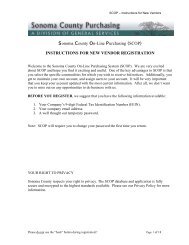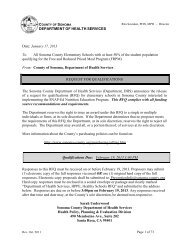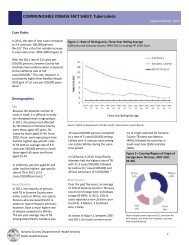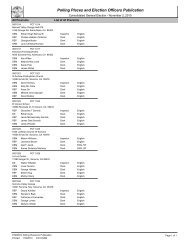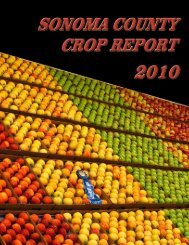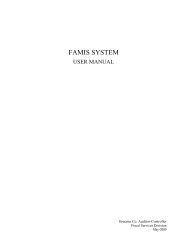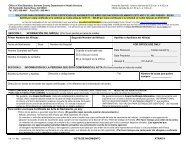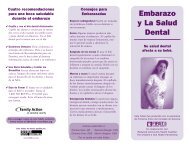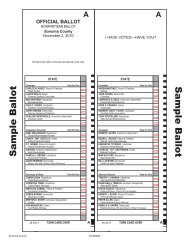New Respiratory Protection Regulation Title 3 ... - Sonoma County
New Respiratory Protection Regulation Title 3 ... - Sonoma County
New Respiratory Protection Regulation Title 3 ... - Sonoma County
You also want an ePaper? Increase the reach of your titles
YUMPU automatically turns print PDFs into web optimized ePapers that Google loves.
<strong>Sonoma</strong> <strong>County</strong> Agricultural Commissioner’s Office<br />
Presents<br />
<strong>New</strong> <strong>Respiratory</strong> <strong>Protection</strong> <strong>Regulation</strong><br />
<strong>Title</strong> 3 CCR Section 6739<br />
for Employee Pesticide Handlers<br />
By Alex McVicker<br />
Agricultural Biologist
Scope<br />
This regulation applies to persons required (either<br />
by label, permit conditions, regulatory requirements<br />
or employer) to wear respiratory protection.<br />
This includes, but is not limited to, mixer/loaders,<br />
applicators, field workers, fumigators, supervisors,<br />
foremen, and those whose work tasks place them in<br />
a pesticide treated environment.<br />
More than likely, this means you.
Definitions:<br />
Filter<br />
A component used in respirators to<br />
remove solid or liquid aerosols from the<br />
inspired air.
Definitions:<br />
Canister or Cartridge<br />
A container with a filter, sorbent, or catalyst,<br />
or combination of these items
Definitions:<br />
Category<br />
Negative Pressure Respirator<br />
Negative pressure<br />
created during<br />
inhalation
Definitions:<br />
Air-Purifying Respirator (APR)<br />
A respirator with an<br />
air-purifying filter,<br />
cartridge, or canister
Definitions:<br />
Filtering Facepiece<br />
A particulate respirator with a filter as an<br />
integral part of the facepiece or with the<br />
entire facepiece composed of the filtering<br />
material
Definitions:<br />
Category<br />
Positive Pressure Respirator<br />
A respirator in<br />
which the pressure<br />
inside the<br />
respiratory inlet<br />
covering exceeds<br />
the ambient air<br />
pressure outside.
Definitions:<br />
Powered Air-Purifying Respirator (PAPR)<br />
An air-purifying respirator that uses a<br />
blower to force the ambient air through air-<br />
purifying elements to the inlet covering.
Definitions:<br />
Category<br />
Atmosphere-Supplying Respirator<br />
• Includes supplied-air respirators<br />
(SARs) SARs) ) and self-contained breathing<br />
apparatus (SCBA)
Definitions:<br />
Supplied Air Respirator (SAR)<br />
An atmosphere-supplying respirator for which<br />
the source of breathing air is not designed to be<br />
carried by the user.<br />
Air compressor to provide supplied air<br />
for example.
Definitions:<br />
Self-Contained Breathing Apparatus<br />
An atmosphere-supplying<br />
respirator
Definitions:<br />
Escape-Only Respirator<br />
A respirator intended to be used only<br />
for emergency exit.
<strong>Title</strong> 3 CCR, Section 6739:<br />
<strong>Respiratory</strong> <strong>Protection</strong><br />
Supercedes Section 6738 (h)
General Requirements<br />
6739 (a)<br />
<strong>Respiratory</strong> <strong>Protection</strong> Program<br />
• Develop a written program when<br />
respirators are necessary or required<br />
by the employer<br />
• Update program as necessary to<br />
reflect changes in workplace<br />
conditions that affect respirator use<br />
conditions<br />
Continued
General Requirements<br />
6739 (a)<br />
<strong>Respiratory</strong> <strong>Protection</strong> Program<br />
• Designate a Program Administrator<br />
who is qualified by appropriate training<br />
or experience to oversee the program<br />
and conduct program evaluations<br />
Continued
General Requirements<br />
<strong>Respiratory</strong> <strong>Protection</strong> Program<br />
6739 (a)<br />
So who is qualified to be a Program Administrator?<br />
– Read and understand “American National Standard for<br />
<strong>Respiratory</strong> <strong>Protection</strong>” (ANZI Z88.2)<br />
or “Small Entity Compliance Guide for the Revised<br />
<strong>Respiratory</strong> <strong>Protection</strong> Standard”<br />
OR<br />
– Take classes about developing a respiratory program<br />
from a college or manufacturing authorized<br />
representative<br />
OR<br />
– Become a certified industrial hygienist
Voluntary Respirator Provision<br />
6739 (b)<br />
• Employer may provide respirators at<br />
worker’s s request or permit workers<br />
to use their own respirators<br />
• If voluntary use is permissible,<br />
employer must provide users with<br />
the Voluntary Respirator Provision<br />
Information<br />
Continued
Voluntary Respirator Provision<br />
6739 (b)<br />
• If respirators are employer-<br />
supplied, employer must do the<br />
elements of a written program to<br />
make sure that the employee is<br />
medically able to use the respirator<br />
Continued
Voluntary Respirator Provision<br />
6739 (b)<br />
EXCEPTIONS:<br />
• Employers are not required to<br />
include in a written program<br />
employees whose only use of<br />
respirators involves voluntary use<br />
of filtering facepieces (dust mask)<br />
• The employee provides their own<br />
respirator
Selection of Respirators<br />
6739 (c)<br />
Respirators must be selected based<br />
on the specific hazards encountered in<br />
the workplace
Selection of Respirators<br />
6739 (c)<br />
• Select a NIOSH-Approved<br />
Respirator<br />
• Select respirators from a<br />
sufficient number of models and<br />
sizes<br />
Continued
Definitions:<br />
Physician or Licensed Health Care<br />
Professional (PLHCP)<br />
An individual whose legally<br />
permitted scope of practice (i.e.,<br />
license, registration, or<br />
certification) allows him/her to<br />
independently provide, or be<br />
delegated the responsibility to<br />
provide, some or all of the health<br />
care services required by<br />
paragraph (d), Medical<br />
evaluation.
Medical Evaluation<br />
6739 (d)<br />
• Employer must provide a medical<br />
evaluation to see if a worker is able to<br />
safely use a respirator<br />
• Employer must identify a PLHCP to<br />
perform medical evaluations using a<br />
medical questionnaire OR an initial<br />
medical examination that obtains the<br />
same information<br />
Continued
Medical Evaluation<br />
6739 (d)<br />
• Evaluation form must be filled out<br />
confidentially during worker’s<br />
normal work hours or at a time and<br />
place convenient to the employee<br />
Continued
Continued<br />
Medical Evaluation<br />
6739 (d)<br />
Employer must provide PLHCP certain information:<br />
Type/Weight of respirator<br />
Duration/Frequency of use<br />
Expected physical effort<br />
Temperature/Humidity extremes<br />
Copy of <strong>Respiratory</strong> <strong>Protection</strong> Program<br />
Copy of <strong>Title</strong> 3, Section 6739
Medical Evaluation<br />
6739 (d)<br />
• After review of the medical<br />
evaluation and/or physical<br />
examination of the worker, PLHCP<br />
shall provide employer with a<br />
written recommendation, subsection<br />
(s)
Medical Evaluation<br />
6739 (d)<br />
• Annual review of medical status IS NOT<br />
REQUIRED<br />
IS NOT<br />
• However, , employer must provide additional<br />
medical evaluations if:<br />
– Worker reports medical symptoms about their ability<br />
to use a respirator<br />
– PLHCP, supervisor, or program administrator informs<br />
that a worker needs to be reevaluated<br />
– Change occurs in workplace conditions that may be a<br />
physiological burden on a worker
Fit Testing<br />
6739 (e)<br />
Before a worker uses any respirator with a<br />
negative or positive pressure tight-fitting<br />
facepiece, the worker must be fit tested<br />
Continued
Definitions:<br />
Qualitative Fit Test (QLFT)<br />
Depends on ability to detect testing<br />
agent and may be falsified (except in<br />
case of irritant smoke)
Definitions:<br />
Quantitative Fit Test (QNTF)<br />
An assessment of the adequacy of<br />
respirator fit by numerically measuring the<br />
amount of leakage into the respirator
Continued<br />
Fit Testing<br />
6739 (e)<br />
• Workers using tight-fitting facepiece<br />
respirators must pass an appropriate<br />
qualitative fit test (QLFT)<br />
or<br />
quantitative fit test (QNFT)
Fit Testing<br />
6739 (e)<br />
• The fit test must be administered<br />
using a Cal/OSHA-accepted accepted QLFT<br />
or QNFT protocol<br />
• <strong>Title</strong> 8 of the California Code<br />
of <strong>Regulation</strong>s , Section 5144,<br />
Appendix A<br />
Continued
Fit Testing<br />
6739 (e)<br />
A little bit of Good <strong>New</strong>s:<br />
–The QLFT is acceptable for ALL<br />
negative-pressure tight-fitting<br />
HALF<br />
or FULL facepiece respirators used<br />
for pesticide applications
Fit Testing<br />
6739 (e)<br />
• Must conduct an additional fit test<br />
whenever the worker reports, or the<br />
employer or PLHCP makes visual<br />
observations of, changes in the<br />
worker’s s physical condition that could<br />
affect respirator fit
Continued<br />
Facepiece Seal <strong>Protection</strong><br />
6739 (f)<br />
A Couple Common Sense Items:<br />
• Respirators with tight-fitting facepieces<br />
must not be worn by workers who have<br />
facial hair or any condition that interferes<br />
with the face-to-facepiece facepiece seal or valve<br />
function<br />
• Corrective glasses or goggles or other PPE<br />
must be worn in a manner that does not<br />
interfere with the face-to-facepiece facepiece seal
Facepiece Seal <strong>Protection</strong><br />
6739 (f)<br />
A Required Good Habit:<br />
• Workers wearing tight-fitting respirators<br />
must perform a user seal check each<br />
time they put on the respirator using the<br />
procedures in <strong>Title</strong> 8, Section 5144,<br />
Appendix B-1 1 or equally effective<br />
manufacturer’s s procedures
Cleaning and Disinfecting<br />
6739 (h)<br />
• Provide each user with a respirator that is<br />
clean, sanitary and in good working order<br />
• Clean and disinfect at the following intervals:<br />
– as necessary when issued for exclusive use<br />
(cleaning only)<br />
– before being worn by different individuals (clean<br />
and disinfect)<br />
– after each use for emergency respirators, fit<br />
testing and training (clean and disinfect)
Emergency Respirators<br />
6739 (i)<br />
• Must be immediately accessible<br />
• Clearly marked as containing emergency<br />
respirator<br />
• Stored according to manufacturer’s<br />
recommendation<br />
• Stored such that it is safely accessible<br />
during emergency conditions
Inspection and Repair<br />
6739 (j)<br />
• Ensure that all respirators are<br />
inspected before each use<br />
• Defective or failed respirators shall be<br />
taken out of service until repaired or<br />
discarded<br />
• Repair of respiratory equipment shall<br />
be done by persons trained to do so<br />
using NIOSH-approved parts.
Identification of Filter, Cartridges and Canisters 6739 (l)<br />
‣All filters, cartridges and canisters<br />
used in the workplace must be labeled<br />
and color coded with the NIOSH<br />
approval label<br />
‣The label must not be removed and<br />
must remain legible
Training and Information<br />
6739 (m)<br />
Employers must provide training to<br />
workers who are required to use<br />
respirators.<br />
Training must be understandable to<br />
workers.<br />
Continued
Training and Information<br />
6739 (m)<br />
• Employees trained to use respirators must be<br />
able to demonstrate knowledge of at least:<br />
– why the respirator is necessary and how improper fit<br />
can compromise protection<br />
– limitations and capabilities of the respirator<br />
– recognition of medical signs that may prevent<br />
effective us<br />
– how to inspect, wear, and<br />
check the seals<br />
– effective use in<br />
emergency situations<br />
– maintenance and storage<br />
Continued
Training and Information<br />
6739 (m)<br />
• Training must be provided prior to use<br />
• Retraining is required Annually, , and<br />
when:<br />
– Changes in the workplace or type of respirator<br />
– Employee has inadequate knowledge<br />
• Advisory information in subsection (r)<br />
must be displayed for workers who<br />
wear respirators voluntarily
Program Evaluation<br />
6739 (n)<br />
• Employers must evaluate the<br />
workplace as necessary to ensure<br />
program is effective<br />
• Must ask workers required to use<br />
respirators about program<br />
effectiveness and assess problems<br />
they see
End-of-Service Life<br />
6739 (o)<br />
Hierarchy of Replacement:<br />
1. Odor, taste or irritation<br />
2. ESLI triggered<br />
3. All disposable Filtering Face Piece (FFP), at end of the<br />
workday<br />
4. According to pesticide-specific label or respirator<br />
manufacturer directions<br />
5. Absent any pesticide-specific directions, at the end of<br />
the workday<br />
* or, as according to manufacturer, on excessive breathing resistance.<br />
*
Recordkeeping<br />
6739 (p)<br />
A record of fit tests must be kept<br />
Written copy of the current program must be kept<br />
Medical recommendations must be kept<br />
• Records required to be kept must be made<br />
available upon request to affected workers,<br />
the local CAC, or others designated by the<br />
Director of DPR<br />
• Records must be kept during employment<br />
requiring respiratory protection and for<br />
three years after such conditions end
Medical Evaluation Questionnaire<br />
6739(q)<br />
Questionnare provided in<br />
regulation, or a substantially<br />
equivalent one, must be completed<br />
by each worker required to wear a<br />
respirator
Voluntary Respirator Provision<br />
6739(r)<br />
Information that must be<br />
provided to workers who<br />
want to wear respiratory<br />
protection when a respirator<br />
is not required by label,<br />
regulation, permit conditions<br />
or employer policy.
Medical Recommendation Form 6739(s)<br />
This form, or one substantially similar,<br />
is used by the PLHCP to state to the<br />
employer if the worker can wear the<br />
respiratory protection<br />
It allows the PLHCP (Physician or<br />
Licensed Health Care Professional) to<br />
recommend other types of respiratory<br />
protection if medically necessary
FORM SOURCES<br />
TEMPLATE FOR A WRITTEN PROGRAM: DOCUMENT HS-1513<br />
AND A COPY OF THE ACTUAL RESPIRATORY REGULATIONS<br />
(SECT 6739)<br />
GO TO WWW.SONOMA-COUNTY.ORG<br />
MEDICAL QUESTIONNAIRE,<br />
MEDICAL RECOMMENDATION FORM,<br />
VOLUNTARY RESPIRATOR INFORMATION<br />
GO TO WWW.SONOMA-COUNTY.ORG<br />
ALSO AVAILABLE IN OUR OFFICE<br />
THE RESPIRATORY HANDOUT HAS SOURCES INFORMATION




